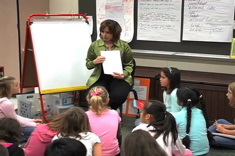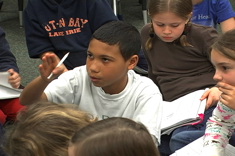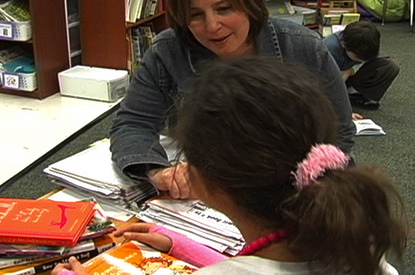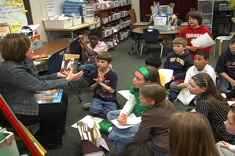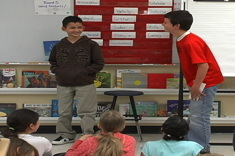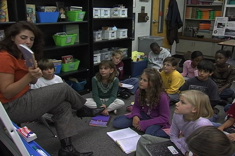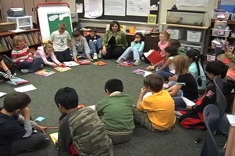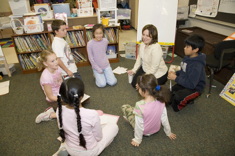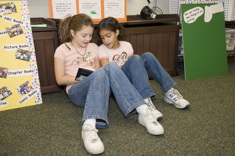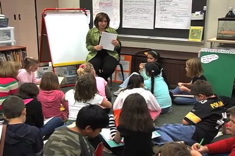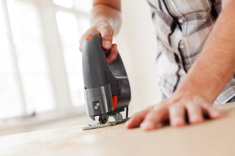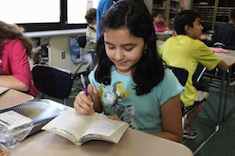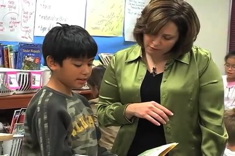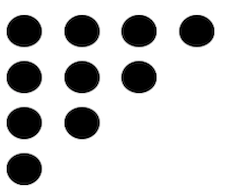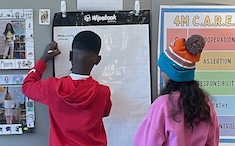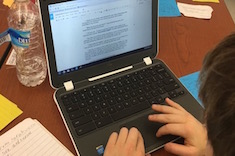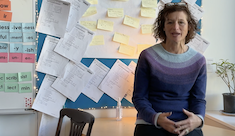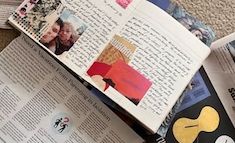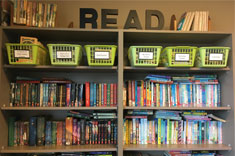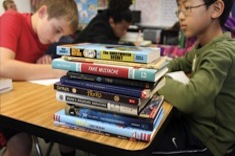4th
Latest Content
Revision Tools: Providing Options to Students
From old favorites like highlighters to new resources like kangaroo bags, this whole-class session with Franki Sibberson's grades 3-4 students highlights cool tools that will inspire learners to dive in and test out different revision strategies in writer's workshop.
Assessing Student Writing
Don't let the pressure of standards and testing take away from the joys of writing workshop. Franki Sibberson explains how assessment helps her infuse energy and excitement into her writing program.
Playing with Word Work: Inviting Students to See Playful Language in Books (BOOKLIST)
Franki Sibberson brings fun into word work through the use of picture books with her 5th graders.
Minilessons to Start Conversations with Students About Books
In leadership positions, the first conversations with students about who you are and what you believe can set the tone for the year. Franki Sibberson has helpful advice for talking with readers — big and small.
Hooked on Series: Great Series Books for Transitional Readers
Finding the right series for a transitional reader is a gift. Franki Sibberson shares her favorite finds.
The “All About Us” Board: Linking Literacy and Community Building All Year Long
Suzy Kaback has terrific tips for an ever-evolving “All About Us” bulletin board to use from the first day of school to the last.
Comprehending Graphic Novels: A Primer for Teachers
Mary Lee Hahn provides a quick primer for teachers new to graphic novels, as well as suggestions for using these novels to teach comprehension.
Writing Workshop Share: Talking About Revision Tools
In this video of a discussion after writing workshop in Franki Sibberson’s classroom, intermediate students share the tools they used in revision.
Organizing Writing Groups
Franki Sibberson describes how she organizing writing groups in her grades 3 and 4 classroom, and shares a video of a writing group considering leads.
Using Foam Boards in Writer’s Workshop
Franki Sibberson explains how she extends the wall space in her classroom for instruction through the use of foam boards.
Reflection Sheets: A Tool for Assessment and Conferring
Franki Sibberson explains how “reflection sheets” work as an assessment tool in her classroom, replacing detailed notes from conferences.
Digging Deep: The Power of Rereading
Max Brand considers how rereading helps students understand and enjoy texts.
Power Tools
Aimee Buckner shares three essential "power tools" for writers.
Mentor Texts and Teacher Modeling: The Listing Strategy
In this video from her fourth-grade classroom, Aimee Buckner teaches the “listing” strategy, using the book This Is the Tree: A Story of the Baobab as a mentor text. Aimee talks about mentor texts, using her own writing as a model, and the needs of intermediate readers and writers during the lesson and interview.
Common Core Conversations: Increasing Argumentative Writing
Teachers continue to puzzle over and sort through the terminology in the Common Core related to opinion and persuasive writing. Amanda Adrian and Heather Rader consider terms and teaching strategies.
Whole Class Interviews: Building Community in Writing Workshop (TEMPLATE)
Interviews early in the year are a potent tool for building a class community.
Word Study is More Than Spelling
Franki Sibberson works to expand her views of spelling and word work, redefining routines in her grades 3 and 4 classroom.
A Strategy Lesson for “Drive-Thru” Readers
Who is a “drive-thru” reader? One who zips through the start of a book and discards it before finishing, moving ever more quickly through random books. Aimee Buckner has some minilesson suggestions for dealing with those students who can’t or won’t finish any books they start.
Dot Images: Taking Time to Reflect Brings Out Mathematical Ideas
Mallory Messenger shares a way to help students slow down and reflect on mathematical ideas. As she poses dot images to the class and collects different ways students see and count each image, students begin to reflect on key ideas. Mallory gives questions that will help students develop a stronger understanding of the concepts.
Giving Kids Time and Space to Show Their Brilliance
Mallory Messenger offers intentional ways to give students time and space to share their learning. This is easier said than done in our fast-paced, standardized-test-driven, mandates-filled world, but with a few intentional strategies, we can slow down the pace just enough to see what our students can really do.
Gratitude Week
Gigi McAllister shares the tradition of Gratitude Week. It gives students an authentic writing experience that has a ripple effect of spreading joy and gratitude throughout the school. It also shows them the significant impact that their words can have on others.
Going Deeper with Math Curricular Materials
Mallory Messenger guides us in taking what our district-adopted math curriculum resources provide and planning small changes by using problem stems and student problem posing to increase the rigor and make mathematical experiences accessible for all students.
Managing Independent Projects (SHORTS)
Tara Barnett and Kate Mills continue their series on independent projects with nuts and bolts advice on management.
Reading Nonfiction: A Paper Anchor Chart
Tammy Mulligan explains her process of using multiple versions of an anchor chart to help students remember and personalize a process for reading nonfiction texts.
Writing as an Act of Resistance and a Source of Strength
In this beautiful personal essay, Stella Villalba reminds us that writing is a source of strength, and developing a community of writers is essential in post-pandemic classrooms.
Launching a Classroom Library
Melissa Styger slows down the launch of the classroom library to ensure it is a valuable resource all year.
Field Experience: Supporting Independent Reading, Choice and Stamina
Helping students learn to choose books and develop stamina are important to developing independent readers. Ruth Ayres designed a field experience with opportunities to see minilessons, small group instruction, team meetings and a share session that support independence in readers.
Using 9/11 Research to Build Community and Writing Process
Katherine Sokolowski gives space for students to research and share their learning about 9/11 in order to build a community of writers, as well as nourish the research and writing process.
Nonfiction Books for Compassion, Inspiration, and Heart
Mandy Robek set out on a quest to discover new nonfiction books with characters who offer inspiration, compassion, and heart. Here are eight new titles you won’t want to miss.
Books That Sustain the Linguistic Lives of Multilingual Learners
We need more bilingual books! Stella Villalba explains why these books are essential and provides a booklist to help sustain the linguistic lives of multilingual learners.
Browse Content By
Type
Category
- Assessment Tools
- Big Fresh Archives
- Booklists
- Choice Numeracy
- Classroom Design
- Common Core
- Community Building
- Conferring
- Content Literacy
- Digital Literacy
- English Language Learners
- Equity
- Family Relations
- Free Samples
- Guiding Groups
- Leadership
- Literacy Coaches
- Mentor Texts
- Minilessons
- New Teacher Mentors
- Podcasts
- Poetry
- Quote Collections
- Reading Strategies
- Self Care
- Struggling and Striving Learners
- Talking and Listening
- Teacher Study Groups
- Teaching Reading
- Teaching Writing
- Word Study and Vocabulary
Author
- Melissa Quimby
- Nawal Qarooni
- Gwen Blumberg
- Julie Cox
- The Lead Learners
- Hannah Tills
- Josie Stewart
- Ruth Metcalfe
- Mallory Messenger
- Becca Burk
- Jodie Bailey
- Vivian Chen
- Mary Brower
- Tiffany Abbott Fuller
- Stephanie Affinito
- Ruth Ayres
- Leigh Anne Eck
- Heather Fisher
- Shari Frost
- Julie Johnson
- Suzy Kaback
- Gigi McAllister
- Shirl McPhillips
- Melanie Meehan
- Cathy Mere
- Debbie Miller
- Tara Barnett and Kate Mills
- Tammy Mulligan
- Dana Murphy
- Bitsy Parks
- David Pittman
- Brenda Power
- Heather Rader
- Matt Renwick
- Mandy Robek
- Christy Rush-Levine
- Gretchen Schroeder
- Jen Schwanke
- Brian Sepe
- Katherine Sokolowski
- Stella Villalba
- Jennifer Vincent
Grade Level
Choice Literacy Membership
Articles
Get full access to all Choice Literacy article content
Videos
Get full access to all Choice Literacy video content
Courses
Access Choice Literacy course curriculum and training


